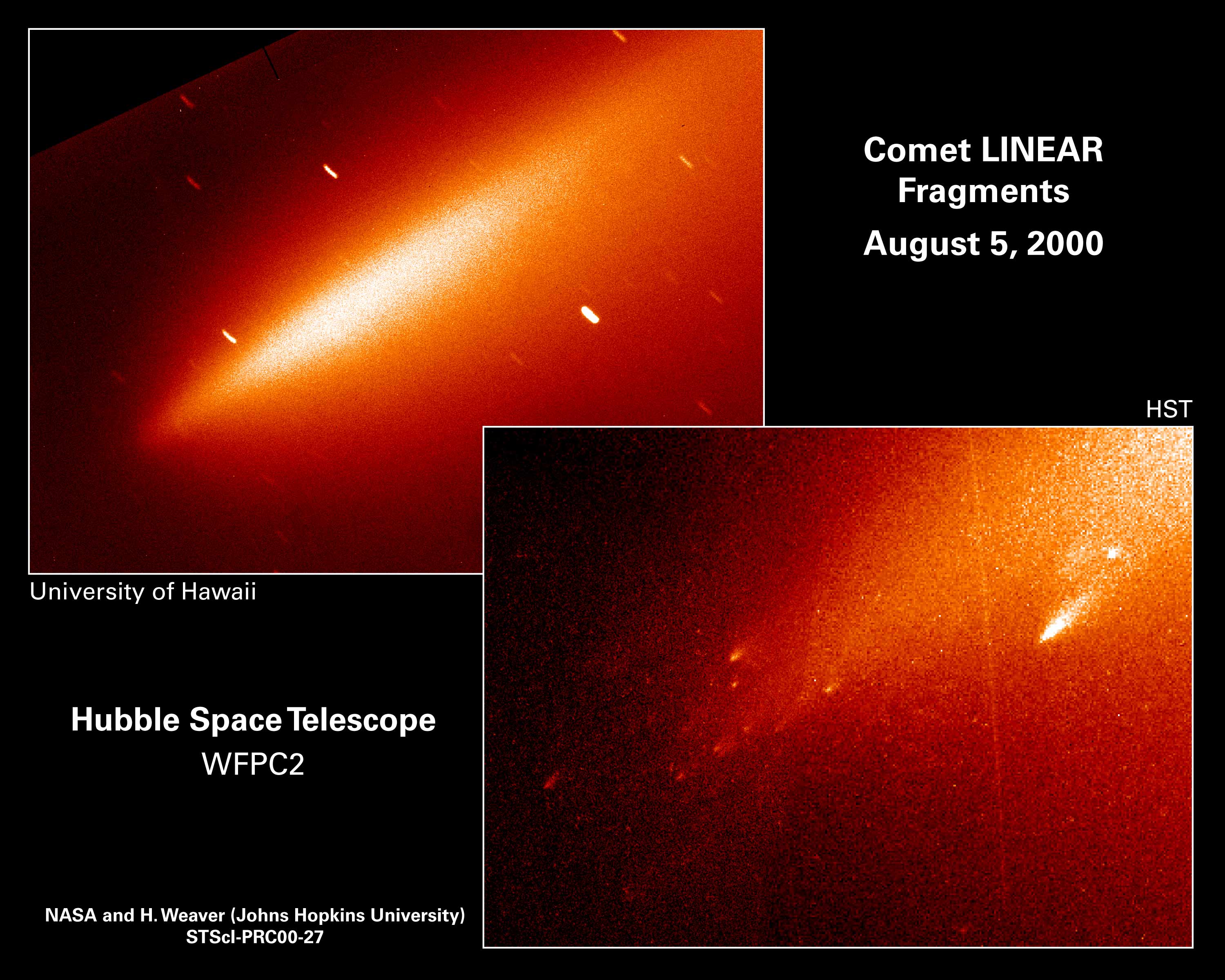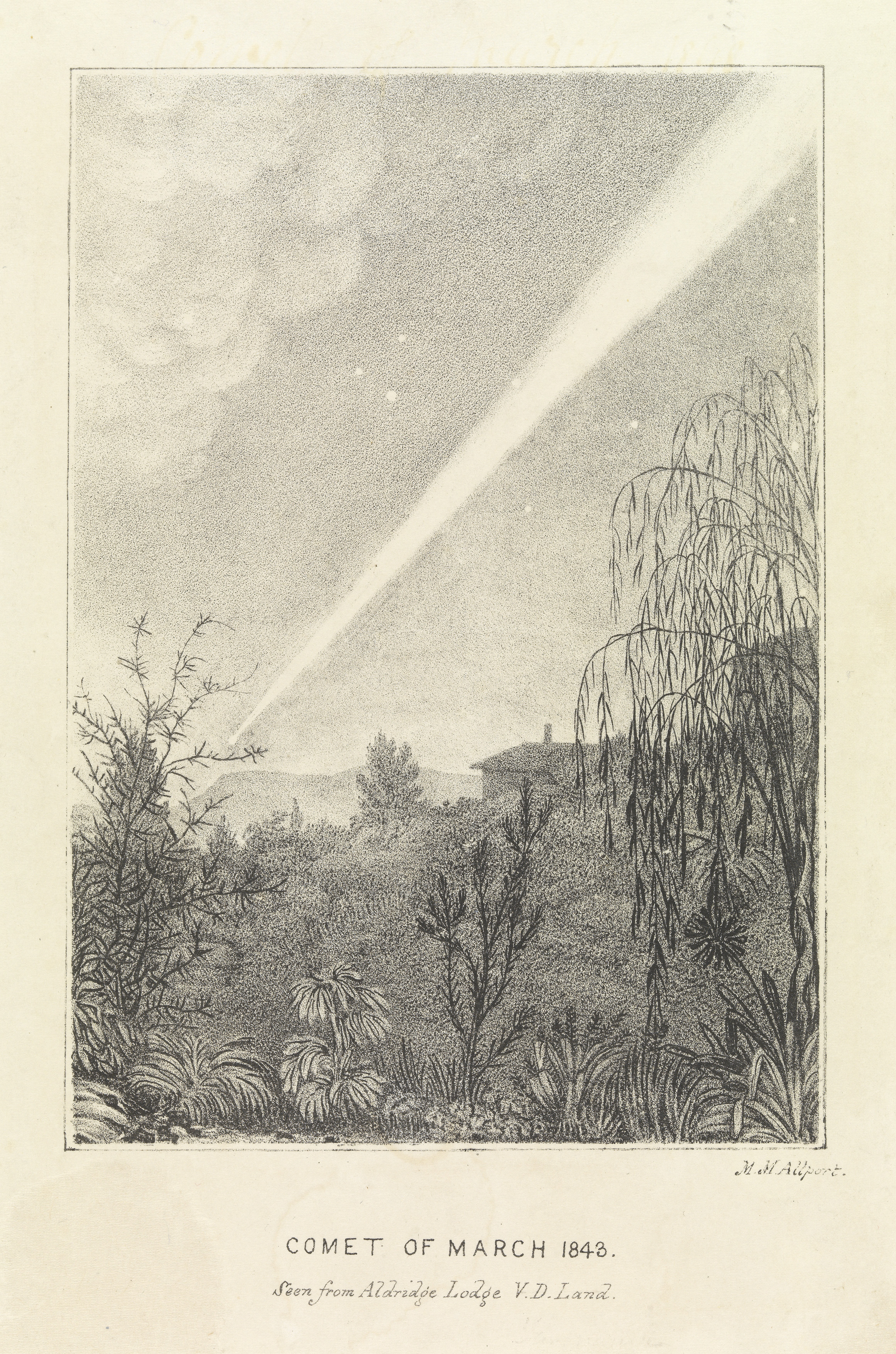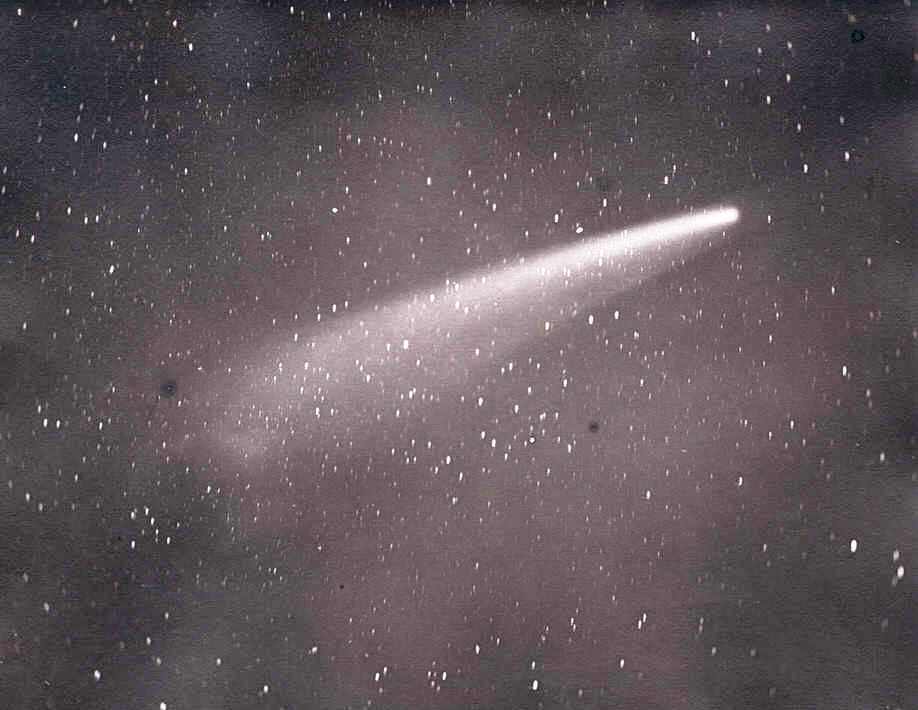|
Comet West
Comet West, formally designated C/1975 V1, 1976 VI, and 1975n, was a comet described as one of the brightest objects to pass through the inner Solar System in 1976. It is often described as a "great comet." History It was discovered photographically by Richard M. West, of the European Southern Observatory, on August 10, 1975. The comet came to perihelion (closest approach to the Sun) on February 25, 1976. During perihelion the comet had a minimum solar elongation of 6.4° and as a result of forward scattering reached a peak apparent magnitude of −3. From February 2527, observers reported that the comet was bright enough to study during full daylight. Despite its brightness, Comet West went largely unreported in the popular media. This was partly due to the relatively disappointing display of Comet Kohoutek in 1973, which had been widely predicted to become extremely prominent: scientists were wary of making predictions that might raise public expectations.Burnham, R. and Le ... [...More Info...] [...Related Items...] OR: [Wikipedia] [Google] [Baidu] |
Parabolic Trajectory
In astrodynamics or celestial mechanics a parabolic trajectory is a Kepler orbit with the eccentricity equal to 1 and is an unbound orbit that is exactly on the border between elliptical and hyperbolic. When moving away from the source it is called an escape orbit, otherwise a capture orbit. It is also sometimes referred to as a C3 = 0 orbit (see Characteristic energy). Under standard assumptions a body traveling along an escape orbit will coast along a parabolic trajectory to infinity, with velocity relative to the central body tending to zero, and therefore will never return. Parabolic trajectories are minimum-energy escape trajectories, separating positive-energy hyperbolic trajectories from negative-energy elliptic orbits. Velocity The orbital velocity (v) of a body travelling along parabolic trajectory can be computed as: :v = \sqrt where: *r is the radial distance of orbiting body from central body, *\mu is the standard gravitational parameter. At any positi ... [...More Info...] [...Related Items...] OR: [Wikipedia] [Google] [Baidu] |
JPL Horizons On-Line Ephemeris System
JPL Horizons On-Line Ephemeris System provides access to key Solar System data and flexible production of highly accurate ephemerides for Solar System objects. Osculating elements at a given epoch (such as produced by the JPL Small-Body Database) are always an approximation to an object's orbit (i.e. an unperturbed conic orbit or a " two-body" orbit). The real orbit (or the best approximation to such) considers perturbations by all planets, a few of the larger asteroids, a few other usually small physical forces, and requires numerical integration. Jet Propulsion Laboratory (JPL) ephemerides do not use things such as periods, eccentricities, etc. Instead, JPL integrates the equations of motion in Cartesian coordinates (x,y,z), and adjusts the initial conditions in order to fit modern, highly accurate measurements of planetary positions. Since August 2013, Horizons has been using ephemeris DE431. During the week of 12 April 2021, the Horizons ephemeris system was updated to ... [...More Info...] [...Related Items...] OR: [Wikipedia] [Google] [Baidu] |
C/1999 S4
C/1999 S4 (LINEAR) was a long-period comet discovered on September 27, 1999, by LINEAR. The comet made its closest approach to the Earth on July 22, 2000, at a distance of . It came to perihelion on July 26, 2000, at a distance of 0.765 AU from the Sun. The comet nucleus was estimated to be about 0.9 km in diameter. Before the comet broke up, the (dust and water) nucleus erosion rate was about 1 cm per day. The comet brightened near July 5, 2000, and underwent a minor fragmentation event. The comet brightened again around July 20, 2000, and then disintegrated. The published optical and most radio data support that the main nuclear decay started July 23, 2000. The dust cloud expanded at about while the fragments expanded at around . Other comets are known to have disappeared, but Comet LINEAR is the first one to have been caught in the act. The orbit of a long-period comet is properly obtained when the osculating orbit is computed at an epoch after leaving the pla ... [...More Info...] [...Related Items...] OR: [Wikipedia] [Google] [Baidu] |
Kreutz Sungrazers
The Kreutz sungrazers ( ) are a family of sungrazing comets, characterized by orbits taking them extremely close to the Sun at perihelion. They are believed to be fragments of one large comet that broke up several centuries ago and are named for German astronomer Heinrich Kreutz, who first demonstrated that they were related. A Kreutz sungrazers's aphelion is about from the Sun; these sungrazers make their way from the distant outer Solar System from a patch in the sky in Canis Major, to the inner Solar System, to their perihelion point near the Sun, and then leave the inner Solar System in their return trip to their aphelion. Several members of the Kreutz family have become great comets, occasionally visible near the Sun in the daytime sky. The most recent of these was Comet Ikeya–Seki in 1965, which may have been one of the brightest comets in the last millennium. It has been suggested that another cluster of bright Kreutz system comets may begin to arrive in the inner Sola ... [...More Info...] [...Related Items...] OR: [Wikipedia] [Google] [Baidu] |
Great Comet Of 1882
The Great Comet of 1882 formally designated C/1882 R1, 1882 II, and 1882b, was a comet which became very bright in September 1882. It was a member of the Kreutz Sungrazers, a family of comets which pass within of the Sun's photosphere at perihelion. The comet was bright enough to be visible next to the Sun in the daytime sky at its perihelion. Discovery The comet appeared in the morning skies of September 1882. Reports suggest that it was first seen as early as 1 September 1882, from the Cape of Good Hope as well as the Gulf of Guinea, and over the next few days many observers in the southern hemisphere reported the new comet. The first astronomer to record observations of the comet was W. H. Finlay, the Chief Assistant at the Royal Observatory in Cape Town, South Africa. Finlay's observation on 7 September at 16h GMT was also an independent discovery, and he reported that the comet had an apparent magnitude of about 3, and a tail about a degree in length. The comet brigh ... [...More Info...] [...Related Items...] OR: [Wikipedia] [Google] [Baidu] |
Smithsonian Astrophysical Observatory
The Smithsonian Astrophysical Observatory (SAO) is a research institute of the Smithsonian Institution, concentrating on astrophysical studies including galactic and extragalactic astronomy, cosmology, solar, earth and planetary sciences, theory and instrumentation, using observations at wavelengths from the highest energy gamma rays to the radio, along with gravitational waves. Established in Washington, D.C., in 1890, the SAO moved its headquarters in 1955 to Cambridge, Massachusetts, where its research is a collaboration with the Harvard College Observatory (HCO) and the Harvard University Department of Astronomy. In 1973, the Smithsonian and Harvard formalized the collaboration as the Center for Astrophysics , Harvard & Smithsonian (CfA) under a single Director. History Samuel Pierpont Langley, the third Secretary of the Smithsonian, founded the Smithsonian Astrophysical Observatory on the south yard of the Smithsonian Castle (on the U.S. National Mall) on March 1 ... [...More Info...] [...Related Items...] OR: [Wikipedia] [Google] [Baidu] |
Perturbation (astronomy)
In astronomy, perturbation is the complex motion of a massive body subjected to forces other than the gravitational attraction of a single other massive body. The other forces can include a third (fourth, fifth, etc.) body, resistance, as from an atmosphere, and the off-center attraction of an oblate or otherwise misshapen body. Introduction The study of perturbations began with the first attempts to predict planetary motions in the sky. In ancient times the causes were unknown. Isaac Newton, at the time he formulated his laws of motion and of gravitation, applied them to the first analysis of perturbations, recognizing the complex difficulties of their calculation. Many of the great mathematicians since then have given attention to the various problems involved; throughout the 18th and 19th centuries there was demand for accurate tables of the position of the Moon and planets for marine navigation. The complex motions of gravitational perturbations can be broken down. The hy ... [...More Info...] [...Related Items...] OR: [Wikipedia] [Google] [Baidu] |
Comet Nucleus
The nucleus is the solid, central part of a comet, once termed a ''dirty snowball'' or an ''icy dirtball''. A cometary nucleus is composed of Rock (geology), rock, dust, and frozen gases. When heated by the Sun, the gases Sublimation (physics), sublime and produce an atmosphere surrounding the nucleus known as the Coma (cometary), coma. The force exerted on the coma by the Sun's radiation pressure and solar wind cause an enormous tail to form, which points away from the Sun. A typical comet nucleus has an Albedo#Astronomical albedo, albedo of 0.04. This is blacker than coal, and may be caused by a covering of dust. Results from the Rosetta (spacecraft), ''Rosetta'' and Philae (spacecraft), ''Philae'' spacecraft show that the nucleus of 67P/Churyumov–Gerasimenko has no magnetic field, which suggests that magnetism may not have played a role in the early formation of planetesimals. Further, the Rosetta (spacecraft)#Instruments, ALICE spectrograph on ''Rosetta'' determined that ... [...More Info...] [...Related Items...] OR: [Wikipedia] [Google] [Baidu] |






.jpg)